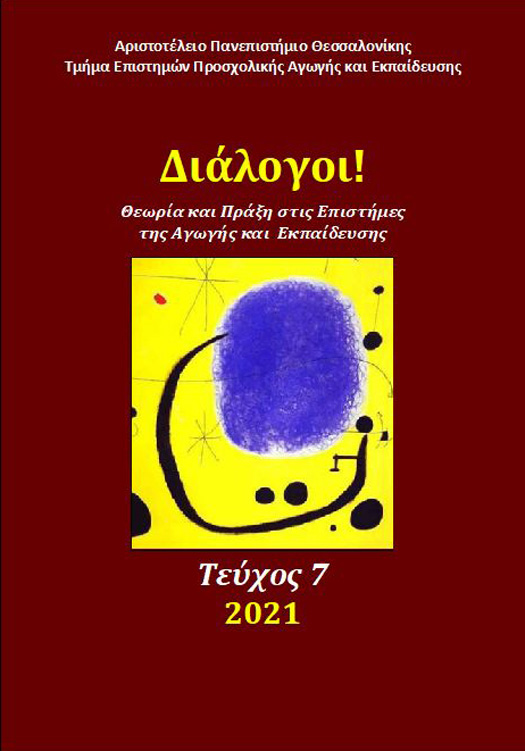Εκτιμήσεις μέτρησης χρόνου: επιδόσεις και στρατηγικές παιδιών και ενηλίκων

Περίληψη
Σκοπός της παρούσας εργασίας ήταν να διερευνήσει την ικανότητα ενηλίκων και παιδιών στην εκτίμηση μέτρησης του χρόνου καθώς και τις στρατηγικές που αυτοί χρησιμοποιούν κατά την εκτίμηση. Για τον σκοπό αυτό, πραγματοποιήθηκε έρευνα στην οποία συμμετείχαν 30 ενήλικες και 32 μαθητές της Στ΄ τάξης του δημοτικού σχολείου. Σχεδιάστηκαν και παρουσιάστηκαν στους συμμετέχοντες τρία έργα, τα οποία τους ζητούσαν: α) να εκτιμήσουν τον χρόνο που τους χρειάζεται για να ολοκληρώσουν ένα παιχνίδι, κάνοντας πρώτα μία μελλοντική εκτίμηση και κατόπιν μία αναδρομική εκτίμηση (Έργο 1: «Μελλοντικές και Αναδρομικές εκτιμήσεις»), β) να εκτιμήσουν τη διάρκεια οικείων ενεργειών (Έργο 2: «Εκτίμηση διάρκειας συγκεκριμένων ενεργειών») και γ) να υποδείξουν τρεις ενέργειες με συγκεκριμένη διάρκεια η κάθε μία (Έργο 3: «Υπόδειξη ενεργειών με συγκεκριμένη διάρκεια»). Όλοι οι συμμετέχοντες πραγματοποίησαν τις εκτιμήσεις τους με τυπικές και άτυπες μονάδες χρόνου. Βρέθηκε ότι οι συμμετέχοντες στο σύνολό τους, ανεξαρτήτως ηλικίας, παρουσίασαν παρόμοιες επιδόσεις στις εκτιμήσεις χρόνου που πραγματοποίησαν. Στο Έργο 1 οι αναδρομικές εκτιμήσεις των συμμετεχόντων ήταν πιο επιτυχημένες από τις μελλοντικές εκτιμήσεις. Για να πραγματοποιήσουν τις εκτιμήσεις τους, οι συμμετέχοντες βασίζονταν κυρίως στη διαίσθησή τους και σε γνωστά προς τους ίδιους σημεία αναφοράς, και πολύ λιγότερο στη χρήση τυπικών μονάδων για τη χρονομέτρηση ή τη γνώση του λεπτού. Στο Έργο 2, περισσότερο επιτυχείς εκτιμήσεις σημειώθηκαν στις ενέργειες με μικρή διάρκεια παρά με μεγάλη διάρκεια. Στο Έργο 3 οι συμμετέχοντες παρουσίασαν πάνω από 65% επιτυχείς εκτιμήσεις στην υπόδειξη ενεργειών με μεγάλη διάρκεια. Τα ευρήματα αυτά αναδεικνύουν την ανάγκη ενίσχυσης της ικανότητας για εκτίμηση μέτρησης του χρόνου από νωρίς.
Λεπτομέρειες άρθρου
- Πώς να δημιουργήσετε Αναφορές
-
Δεσλή Δ., & Ξενίδου Ε. (2021). Εκτιμήσεις μέτρησης χρόνου: επιδόσεις και στρατηγικές παιδιών και ενηλίκων. Διάλογοι! Θεωρία και πράξη στις επιστήμες αγωγής και εκπαίδευσης, 7, 58–78. https://doi.org/10.12681/dial.25323
- Τεύχος
- Τόμ. 7 (2021)
- Ενότητα
- Επιστημονική Αρθογραφία

Αυτή η εργασία είναι αδειοδοτημένη υπό το CC Αναφορά Δημιουργού – Μη Εμπορική Χρήση – Παρόμοια Διανομή 4.0.
Οι συγγραφείς των άρθρων που δημοσιεύονται στο Διάλογοι! Θεωρία και Πράξη στις Επιστήμες Αγωγής και Εκπαίδευσης διατηρούν τα δικαιώματα πνευματικής ιδιοκτησίας επί των άρθρων τους, δίνοντας στο περιοδικό το δικαίωμα της πρώτης δημοσίευσης. Άρθρα που δημοσιεύονται στο Διάλογοι! Θεωρία και Πράξη στις Επιστήμες της Αγωγής και Εκπαίδευσης διατίθενται με άδεια Creative Commons 4.0 και σύμφωνα με την άδεια μπορούν να χρησιμοποιούνται ελεύθερα, με αναφορά στον/στη συγγραφέα και στην πρώτη δημοσίευση για μη κερδοσκοπικούς σκοπούς και με δικαίωμα τροποποίησης μόνον με παρόμοια διανομή (αν αναμείξετε, τροποποιήσετε, ή δημιουργήσετε πάνω στο υλικό, πρέπει να διανείμετε τις δικές σας συνεισφορές υπό την ίδια άδεια όπως και το πρωτότυπο).
To Τμήμα Επιστημών Προσχολικής Αγωγής και Εκπαίδευσης του Αριστοτέλειου Πανεπιστημίου Θεσσαλονίκης και το Εθνικό Κέντρο Τεκμηρίωσης διατηρούν το δικαίωμα να δημοσιεύουν, να αναπαραγάγουν, να παρουσιάζουν στο κοινό, να διανέμουν και να χρησιμοποιούν άρθρα που δημοσιεύονται στο Διάλογοι! Θεωρία και Πράξη στις Επιστήμες Αγωγής και Εκπαίδευσης σε οποιοδήποτε μέσο και μορφή είτε μεμονωμένα είτε ως μέρη συλλογικών έργων, για όλο το χρόνο διάρκειας προστασίας της πνευματικής ιδιοκτησίας και για όλες τις χώρες του κόσμου.
Αυτό περιλαμβάνει ενδεικτικά, και όχι αποκλειστικά, το δικαίωμα δημοσίευσης των άρθρων σε τεύχη του περιοδικού Διάλογοι! Θεωρία και Πράξη στις Επιστήμες Αγωγής και Εκπαίδευσης, αναπαραγωγής και διανομής μεμονωμένων αντιγράφων των άρθρων, αναπαραγωγής ολόκληρων των άρθρων σε άλλη έκδοση του Τμήματος Επιστημών Προσχολικής Αγωγής και Εκπαίδευσης του Αριστοτέλειου Πανεπιστημίου Θεσσαλονίκης και του Εθνικού Κέντρου Τεκμηρίωσης και αναπαραγωγής και διανομής των άρθρων ή περίληψης αυτών με χρήση πληροφορικού συστήματος αποθετηρίου.


